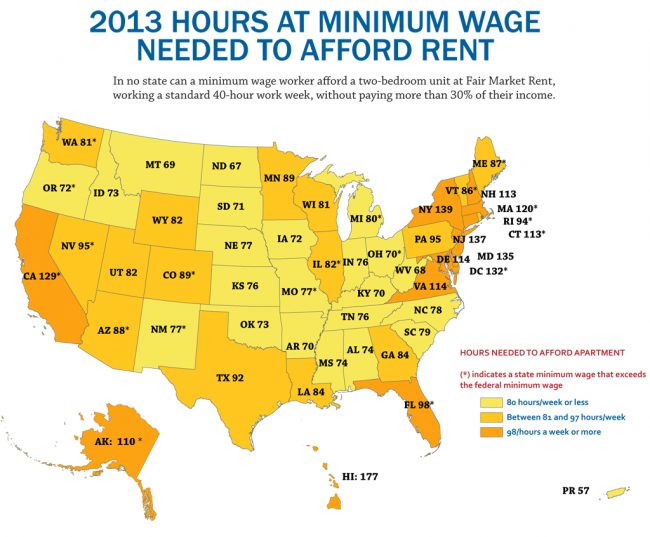
We are celebrating 15 years — and counting — of stories that are deeply researched and deeply felt, that build a historical record of what the city has been.
We are celebrating 15 years — and counting — of stories that are deeply researched and deeply felt, that build a historical record of what the city has been.

Image via National Low Income Housing Coalition
OUT-OF-REACH HOUSING
A new report by the National Low Income Housing Coalition demonstrates the very concerning statistic that “in no state can a minimum wage worker afford a two-bedroom unit at Fair Market Rent, working a standard 40-hour work week, without paying more than 30% of their income.” The report breaks down affordability by state, noting that in New York renters would have to earn $25.25 per hour working a standard work week to pay the recommended 30% or less of their income on an unsubsidized two-bedroom apartment. In response to the report, Matthew Yglesias on Slate points out that many “blue” states with favorable reputations for labor rights are actually among the least affordable, due in part to regulatory and other kinds of restrictions on housing supply. Shane Phillips, a transportation and urban policy blogger, adds to the picture with a broader analysis of household expenses, arguing that those higher housing costs may be partially offset by better transit, whereas renters in auto-dependent locales suffer from expensive housing and the financial burden of auto ownership. Parking requirements in auto dependent places also add significantly to construction cost, driving the overall price of housing up.

Chinatown in Flushing, Queens | Image via Wieland Van Dijk
A FRESH TAKE ON A CHANGING NEIGHBORHOOD
The predominant narrative of gentrification in New York City (or anywhere else) reads as follows: artists and young people move into minority or working-class neighborhoods for cheap rent, they are followed by wealthier residents, and the initial character of the neighborhood is erased. The gentrification in Flushing, Queens, according to Jefferson Mao, offers an illuminating counter-example to this formula: the neighborhood has maintained its identity as a step on the social mobility ladder for Asian immigrants — in what was once a withering center of the white middle class — despite new luxury developments riding the coattails of burgeoning commercial and culinary sectors. In looking at Flushing, Mao calls for “an urban experience defined by fluidity and dynamism” rather than trying to preserve “a way of life that is, for many residents, simply undesirable in the long run.”
GROUND ZERO ARTS HUB
Plans for a vibrant cultural destination at Ground Zero originally included four arts institutions anchoring a new performing arts center. Over the years, three of the anchors dropped off, leaving the dance-focused Joyce Theater as the only permanent tenant. This week, the City announced new plans for a multidisciplinary space that will offer music, film, and theater in addition to dance. The center, to be designed by Frank Gehry, has encountered numerous complications shrinking its size and program. And questions remain about how the new space can adapt to the future of performance art that is moving increasingly away from traditional performing spaces towards more adaptable and fluid designs. Critics also point out that the city already has a number of multidisciplinary venues built and under construction, many of which are already struggling for support.
BOULEVARD 41
Over the past decade, New York City’s Department of Transportion has reworked several marquee streets across the city to expand space for pedestrians and bicyclists, at the expense of traffic lanes and parking. Now a private group of business owners in Midtown is proposing the extension of these principles to the block of 41st Street between Broadway and 6th Avenue. The plan calls for the removal of parking space to make way for sidewalk seating and trees that would provide an improved pedestrian connection to Bryant Park while maintaining some traffic flow, steps the owners see as positive for business.
BIG DATA IN THE BIG APPLE
New York City’s Office of Policy and Strategic Planning, or as The New York Times describes them, the “geek squad of civic-minded number-crunchers,” processes one terabyte — 1000 gigabytes — of public data a day in order to help the City address multi-faceted problems. Over the last three years, the agency has leveraged “Big Data” to double the success rate in finding bootleg cigarettes, speed the removal of trees destroyed by Hurricane Sandy, steer overburdened housing inspectors directly to lawbreaking buildings where fires were the most likely to occur, and pinpointed restaurants illegally dumping grease into the sewer system — causing half of the city’s clogged drains — with a 95% success rate. By translating the data into digestible terms for city officials, the office has allowed for a surprisingly intimate understanding of New York and the development of more effective and efficient solutions.

The Coney Island Cyclone is open for the first season after Hurricane Sandy devastated Coney Island | Image via Luna Park
SANDY UPDATES
While the cleanup from Sandy continues, the Department of Sanitation, US Army Corps of Engineers, and EPA are working to ensure that the approximately 430,000 tons of debris collected following the storm are disposed of appropriately. Sorting through mounds of discarded items and wreckage at temporary transfer sites, workers have diverted 1,100 tons of scrap metal for recycling while a concerted effort to identify and collect hazardous materials not fit for the landfill is ongoing, especially in affected areas where structure demolition continues. In contrast to Governor Cuomo’s plan to provide residents of demolished houses with a buyout for their land to be kept undeveloped going forward, Mayor Bloomberg proposed his own buyout plan, which calls for the acquired land to be redeveloped in accordance with guidelines such as FEMA’s new flood maps, a proposal that has come under fire by some for “ignoring climate change” and setting the city up for more destruction as sea levels rise and stronger storms bear down on coastal neighborhoods. Further recovery plans were outlined by the City this week as it prepares to present allocations for $1.77 billion in Community Development Block Grants to the federal Department of Housing and Urban Development (HUD). Bloomberg announced that under the current proposal housing rehabilitation will receive $720 million, business improvements $185 million, and infrastructure projects $140 million. These federal dollars represent approximately 10% of the $6.3 billion the City will spend on the recovery, and the other 90% will also be funded by the federal government through FEMA, a bump-up from the 75% reimbursement for disasters usually authorized by the agency. In one optimistic sign of recovery, theme parks on Coney Island opened for the season this week with a ceremonial egg-cream christening of the Cyclone, bringing one of the best opening day crowds in recent memory despite ongoing hardship in the adjacent community.
EVENTS and STUFF TO DO
FOLLY
This weekend is your last chance to check out Curtain, on display at Socrates Sculpture Park along the East River in Astoria. The project was the winning entry in Folly, a design competition sponsored by the the Architectural League and Socrates Sculpture Park that invites emerging architects and designers to propose contemporary interpretations of the architectural folly, traditionally a fanciful, small-scale building or pavilion sited in a garden or landscape to frame a view or serve as conversation piece. Before visiting, head over to Archleague.org for an interview with Jerome Haferd and K. Brandt Knapp, the winning designers. And stay tuned for the announcement of this year’s Folly winner, coming next week.
MADE IN THE LES STOREFRONT
Made in the Lower East Side (MiLES), an initiative to transform vacant retail space into active community hubs, will open its first storefront on Monday, April 1st, in the FABWORKS space on Fourth Street in the East Village. The space will host co-working during the weekdays, events and classes in the evenings, and pop-up shops on the weekends. Drop in to explore the space during an open house from 2-7pm today (Friday) or Sunday, or see the space in action after Monday.
THE BIG SQUEEZE
Micro-apartments and small modular living spaces are getting a lot of attention lately. To shed more light on the true value and possibility of these smaller accommodations, the Center for Urban Pedagogy (CUP) teamed up with a group of high school students from Bushwick’s Academy of Urban Planning to investigate the growing movement and will present their project and findings at the Tenement Museum next Thursday at 7pm. Following the presentations will be a panel discussion on the future of housing with past Urban Omnibus interviewees Seema Agnani, Executive Director of Chhaya CDC, and Andrew Reicher, Executive Director of the Urban Homesteading Assistance Board. To reserve a spot, RSVP by 5pm on Tuesday to info@welcometocup.org.
CALL BACK TO 1993
The New Museum — as part of its exhibition NYC 1993: Experimental Jet Set, Trash and No Star (on view through May 26th) — has linked 5,000 of Manhattan’s existing payphones to the past. Dial 1-855-FOR-1993 on any Manhattan payphone and you will hear testimony of what was happening on that block 20 years ago. For you readers far away from Manhattan’s sidewalks, listen to some of the recordings here.
BROADWAY: 1,000 STEPS
Next week, the Center for Architecture will host a panel discussion with speakers from the fields of art and science as part of Broadway: 1,000 Steps, an exhibit documenting the current evolution of a project initiated by Mary Miss/City as Living Laboratory (MM/CaLL) to transform Broadway into a “green corridor” through collaborative projects by artists, designers, scientists, and citizens to “reveal our connections to and our dependence upon the resources supplied by the natural environment.”
DELANCEY FENCE COMPETITION
As pedestrians continue to take back portions of New York streets, the Lower East Side Business Improvement District is hosting a competition for fences to separate new public plazas along Delancey Street on the approach to the Williamsburg Bridge from the bordering traffic and parking lots. Submissions should highlight and pay homage to the cultural and creative institutions nestled in the surrounding streets.
The Roundup keeps you up to date with topics we’ve featured and other things we think are worth knowing about.
The views expressed here are those of the authors only and do not reflect the position of The Architectural League of New York.